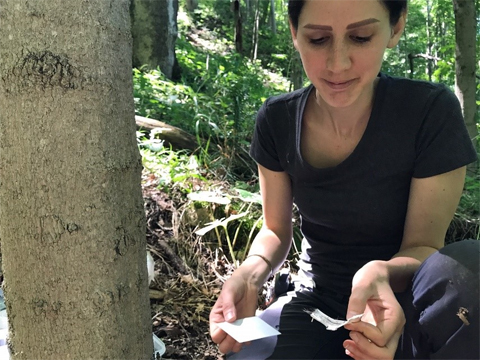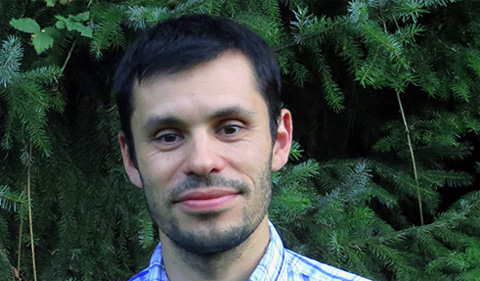
Graduate student Heidi Bencin collecting bobcat hair samples at one of the 160 survey stations in Southeast Ohio.
Bobcats (Lynx rufus) are making a comeback in Ohio after more than a century since their extirpation in the 1850s. Bobcat sightings have been steadily increasing since the 1980s, signaling that they are on their way to reclaiming their former territory, particularly in Southeastern Ohio.
Dr. Viorel Popescu, Assistant Professor of Biological Sciences, and researchers in his Conservation Ecology Lab are working to understand the ecology of Ohio’s recovering bobcat population and inform the management and conservation of this beloved feline.

Dr. Viorel Popescu
DNR Grant Supports Graduate, Undergraduate Student Research
For this research, Popescu’s lab collaborates closely with the Ohio Department of Natural Resources and Division of Wildlife, which awarded $245,000 to support graduate research and undergraduate student training in the lab over the next four years.
- Looking for undergraduate researchers: Research in Popescu’s lab targets a variety of wildlife ecology and conservation issues, such as impacts of climate change, roadways or overexploitation on species and ecosystems, and it is focused mainly on carnivores, amphibians and reptiles. “We are always welcoming motivated undergraduate researchers to join our research group,” he says.
The overall goal of this project is to investigate the sustainability of Ohio’s bobcat population, its pace of recovery, and major sources of mortality that may affect its viability in the long term.
To achieve these objectives, the researchers will build on existing data from the Ohio DNR and collect non-invasive data via camera trapping and genetic sampling. These data will provide the first estimations of bobcat abundance in Ohio, and will set the foundation for sound bobcat management and conservation in the state.

Bobcat caught on camera on July 13, 2017.
Modeling Bobcat Populations with DNA Markers
Research started earlier this summer with financial support from Ohio University through a Student Enhancement Award and an Ohio Center for Ecology and Evolutionary Studies Fellowship awarded to graduate student Heidi Bencin. Bencin and a team of six to eight undergraduate researchers and volunteers spent months traveling the back roads of Southeast Ohio, setting bobcat survey stations using camera traps and hair traps made from glue boards.
The images captured by camera traps will tell the story of where these fancy cats are likely to be found in Ohio. The hair samples will allow the identification of individual bobcats using DNA markers; this information can then be fed into population models to evaluate the abundance of bobcats.
But how is bobcat hair collected? The secret is a stinky attractant that Bencin and her team used to bait the survey stations. (See Luring Bobcats with ‘Chanel #5 for Kitties’.) This attractant contains catnip and other goodies, which makes bobcats very excited; so excited, that they start rubbing all over the tree and the sticky traps, leaving clumps of hair behind. The team collects hair weekly and stores it in small envelopes before sending it to a genetic lab for processing. Another source of non-invasive DNA information is scat! The team collected some bobcat scat this summer and will implement a larger search next summer using scat-detection dogs (stay tuned!).
For updates, follow us on Twitter #RealBobcatsofOhio, and check out our lab website.



















Comments